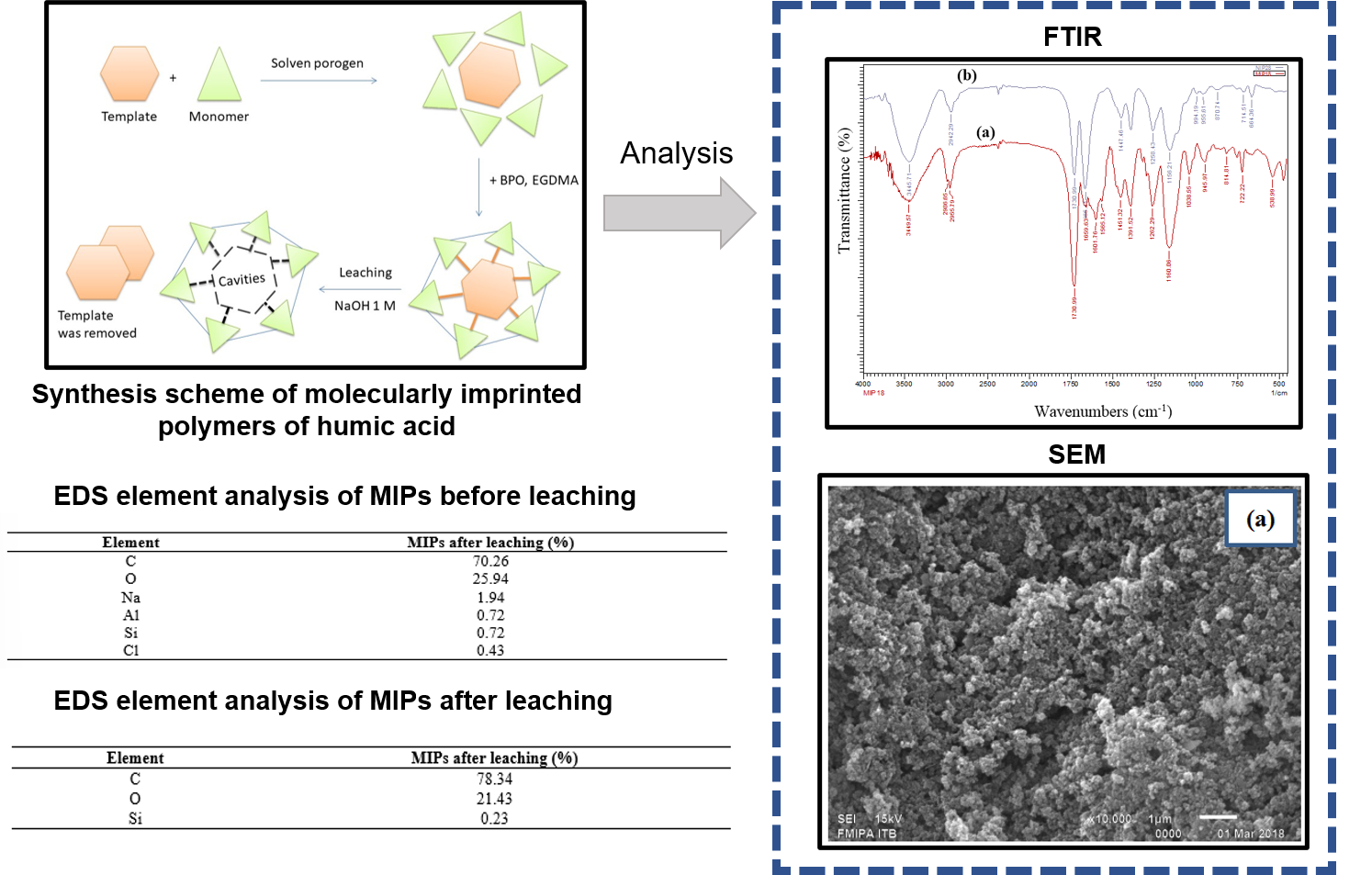Synthesis and Characterization of Molecularly Imprinted Polymers (MIPs) Using Humic Acid
Abstract

MIPs was synthesized through microwave assisted organic synthesis (MAOS) method by using methyl methacrylate (MMA) as functional monomer, ethylene glycol dimethacrylate (EGDMA) as cross-linker, benzoyl peroxide (BPO) as initiator, N,N-dimethyl formamide (DMF) as porogen solvent, and (HA) as template. The MIPs was successfully synthesized according to the characterization using Fourier transform infrared (FTIR) spectroscopy, scanning electron microscope (SEM), electron dispersive spectrometer (EDS), and UV spectrophotometer. FTIR shows the other functional groups peaks in the FTIR spectra of NIPs and MIPs after leaching were appeared at the wavelength of 2955 cm-1 corresponded to stretching vibration of C-H of 1459 cm-1 and 1160.06 cm-1 corresponded to the vibration bands of CH3 and O-CH3. EDS shows the MIPs after leaching have the elemental compositions of C, O, and Si with a mass of 78.34, 21.43, and 0.23%. UV spectrum shows the MIPs and NIPs have absorbance values of 0.36 nm and 0.44 nm
References
[1] A. F. Elsheikh, U. K. Ahmad and Z. Ramli, Investigations on humic acid removal from water using surfactant-modified zeolite as adsobent in a fixed-bed reactor, Application water science. vol. 7, pp. 2843-2856, 2016.
[2] A. Matillainen, E. T. Gjessing, T. Lahtinen, L. Hed, A. Bhatnagar and M. Sillanpaa, An overview of the methods used in the characterisation of natural organic matter (NOM) in relation to drinking water treatment, Chemosphere, vol. 11, pp. 1431-1442, 2011.
[3] J.-K. Yang and S.-M. Lee, Removal of Cr(VI) and humic acid by using TiO2 photocatalysis, Chemosphere, vol. 63, pp. 1677-1684, 2005.
[4] M. A. Zulfikar, D. Wahyuningrum, R. R. Mukti and S. Henry, Molecularly imprinted polymers (MIPs): a functional material for removal of humic acid from peat water, Desalination and Water Treatment, pp. 1-12, 2015.
[5] N. C. Birben, C. S. Uyguner-Demirel, S. S. Kavurmaci, Y. Y. Gurkan, N. Turkten, Z. Cinar and M. Bekbolet, Application of Fe-doped TiO2 specimens for the solar photocatalytic degradation of humic acid, Catalysis Today, 2016.
[6] C. Trellu, Y. Pechaud, N. Oturan, E. Mousset, D. Huguenot, e. D. Hullebusch, G. Esposito and M. A. Oturan, Comparative study on the removal of humic acids from drinking water by anodic oxidation and electro-Fenton, Applied Catalysis B: Environmental, 2016.
[7] D. Suherman and N. Sumawijaya, Removing colour and organic content of peat water using coagulation and floculuation method in basaltic condition, Geological and mining research, vol. 23, pp. 127-139, 2013.
[8] L. Zhao, F. Luo, J. M. Wasikiewicz, H. Mitomo, N. Naotsugu, T. Yagi, M. Tamada and F. Yoshii, Adsorpsion of humic acid from aqueous solution onto irradiation-crosslinked carboxymethylchitosan, Bioresourse Technology, vol. 99, pp. 1911-1917, 2007.
[9] L. Liang, L. Luo and S. Zhang, Adsorption and desorption of humic acid and fulvic acids on SiO2 particles at nano and micro-scales, Coloid Surf., A, vol. 384, pp. 126-130, 2011.
[10] M. A. Zulfikar, E. Novita, R. Hertadi and S. D. Djajanti, Removal of humic acid from peat water using untreated powdered eggshell as a low cost adsorbent, Environ. Sci. Technol. 2013.
[11] M. S. Gasser, H. T. Mohsen and H. F. Aly, Humic acid adsorption onto Mg/Fe layered double hydroxide, Colloids Surf. A, vol. 331, pp. 195-201, 2008.
[12] I. S. Saputra, D. O. B. Apriandanu, Y. Yulizar, E. Maryanti, Y. N. Permana, S. Suhartati, A facile preparation of ZnO/Au nano-needles: optical, morphological and structural properties, Optical Materials. 121, 111628, 2021.
[13] X. Song, J. Li, J. Wang and L. Chen, Quercetin molecularly imprinted polymers: preparation, recognition characteristics and properties as sorbent for solid-phase etraction, Talanta, vol. 80, pp. 694-702, 2009.
[14] R. Sedghi, B. Heidari and M. Yassari, Novel Molecularly imprinted polymer based on cyclodextrin@graphene oxde: synthesis and application for selective diphenylamine determination, colloid and interface science, vol. 503, pp. 47-56, 2017.
[15] P. Lullinski, D. Klejn and D. Maciejewska, Synthesis and characterisation of imprinted sorbent for separation of gramine from bovine serum albumin, Material Science and Engineering C, vol. 65, pp. 400-407, 2016.
[16] B. Ruckert and U. Kolb, Distribution of molecularly imprinted polymer layers on macroporous silica gel particles by STEM and EDX, Micron , vol. 36, pp. 247-260, 2004.
[17] F. Saadati, F. Ghahramani, H. Shayani-Jam, F. Piri and M. R. Yaftian, Synthesis and characterization of nanostructure molecularly imprinted polyaniline/graphene oxide composite as highly selective electrochemical sensor for detection of p-nitrophenol, Taiwan Institute of Chemical Engineers, vol. 86, pp. 213-221, 2018.
Refbacks
- There are currently no refbacks.

This work is licensed under a Creative Commons Attribution-NonCommercial 4.0 International License.








